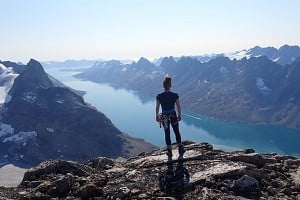
Why do grand ideas always start life over a pint in your local?
Sitting in Bristol's fabulous Port of Call on a cold and damp February evening, we got talking: “How about an unclimbed peak? It's within our scope and we could do it this year?”
Fast-forward to September and we're at the Virgin Atlantic check-in, arguing with the staff over our less than generous baggage allowance. We had seven months to prepare. To be successful you need to plan, prepare and practice. We achieved most of our plans but naturally there were some tasks we left to the last minute and suffered because of it.
This is our story of a small team with big ideas, how we prepared, struggled and learnt from out experiences.
The team consisted of Al Boardman and Elliott Forge who had previous first-ascent experience on a trip to the Pamirs, whilst Jane Cooper and I have been leading climbing and walking trips around the world for the past 10 years.
Location:
After much discussion we settled on a remote corner of the Indian Himalaya, Zanskar. A hugely knowledgeable friend Seb Mankelow, who has been on countless treks and climbs in this area guided us to a number of specific areas. Al also knew the area having filmed “Special Delivery” there in 2007, which was shown at the Kendal Film Festival.
Costs:
Seb put us in touch with Zanskar legend, Sonam “Jimmy” Stobgais. He was able to help us accurately budget for the 17-day expedition, which included horses, cook, assistants, travel and accommodation costs. Using local agents is not only cheaper but the money goes direct to the source. We also had a contingency fund; ours was almost all spent before we even left Heathrow on a small-print/weight-allowance fiasco.
We booked flights to Delhi, transfer flights to Leh and arranged the 2 day transport to Padum, the nearest town before our walk-in.
Emergency procedures:
Jane took charge of first aid and had us doing worst-case scenarios in my living room! These were crucial sessions to put emergency procedures in place. Our insurance with Campbell Irvine gave us access to 24hr emergency on-call doctors as well as evacuation support. We left two friends with all of our emergency contact details in the UK and arranged local support in Zanskar.
Communications:
The satellite phone was an essential part of our emergency kit. I also swear by radios as there is only so much you can discuss with a rope pull. Radios can fail but until they do they're great. They worked perfectly well even without a line of sight over a 2km.
Fitness:
I run adventure races and mountain marathons and they simply do not compare to the gradual decline in fitness you experience at altitude. Simply reaching base camp after 12 days of travel and acclimatisation was exhausting and this was before we climbed anything. I don't think you can ever be fit enough for an expedition.
Climbing Preparation:
Working as a team was key. Before the trip, we got out climbing and walking and decided on universal ideas such as belay stances and rope management, which needed to be second nature to all of us. Climbing on long easy routes, like Commando Ridge, at Bosigran, allowed ideas to be discussed and big boot climbing to be admired. We also practised rescue techniques, which were less than successful first time round.
Food:
Our cook, Punsok , sourced the bulk of our food in Padum. We were very lucky to have a fabulous cook on board, it made all the difference when daal and rice is your staple diet. There aren't enough calories in rice and daal for the amount of exercise we were doing, so we had to supplement it with high-energy treats like nuts, dried apricots and 600-calorie peanut bars that were sourced in Leh. However, we couldn't find Earl Grey tea though, much to Jane's horror.
Maps:
If you are planning an exploratory trip, Google Earth can be a great starting point. There are no decent commercially available maps of Zanskar so we had to use Google Earth. You can copy the images over to Google map and transfer these to contour maps. Having this much information to hand still led to the locals arguing about the location of base camp.
Travel:
We weighed our bags accurately, but still Virgin wanted to charge us £1300 excess. We managed to negotiate considerably but a simple solution is to wear as much as possible onto the plane, especially big boots. Mountain flights are notoriously delayed or cancelled; have a contingency plan for travel and accommodation. Corruption and bribery is rife in countries like India, be aware of the possibilities. We were even asked for camping fees for our isolated base camp at 4500m.
Equipment:
Don't wait until the last minute to buy kit. Discovering my brand new battery didn't hold its charge was very frustrating. Testing every piece of kit is really important, even going to your local ice wall to get used to your new plastics. Beg and borrow, you may even find a friendly manufacturer. But remember to give something back; write a review or send photos of the kit in use.
You will find expedition kit lists on many websites. For clothing, I find layering is the best and pre-empting your work rate will reduce sweating and so keep you warm. I took a Rab summit 900 sleeping bag, a ridgerest and a thermarest , we borrowed a Marmot Asgard tent, and all took base camp slippers; the more comfortable you are at base camp the easier life will be. With temperatures ranging from -20 to +15oC we needed a real variety of equipment.
Most of the information was from experience and found through research. I'm sure there are lots I have forgotten to mention about pre-planning and there are plenty of ways of doing expeditions but my most important advice is to plan worst-case scenarios; they will make you think of everything you need.
The Expedition:
Our walk-in began from a small village a few hours drive from Padum, where we met our 10 horses, cook, assistant and a plethora of locals wanting to know why we were walking into their valley.
After 2 days we reached base camp at the end of the Reru East valley, known locally as Katkar. Our original planned base camp proved too difficult for our horses due to the steep rocky approach. Apparently yaks would have coped. Anxious to get out for a recce we headed out of camp on our first day. We over did it and found ourselves at 5,000m with big boots and carrying kit, which proved too much this early on. Al was put on a course of antibiotics as his chest infection worsened. This delayed our plans but gave everyone another desperately needed rest day. After several days or recces we established a possible location for our advanced base camp.
The following day Al, Elliott and I, with the help of our cook and his assistant, set up an advanced base camp (ABC) at 5200m. Our view was of a valley containing 3 unclimbed peaks. On our first day, to get a better look at the three peaks, we broke trail through deep snow. It proved demoralising as we covered barely 1km in 2.5hrs. Simple tasks brought a lack of breath, which only exasperated our concerns. Moral was low in the tent but after another rest day we decided that, being British, we weren't about to quit.
After much discussion and viewing our photos we decided to tackle the middle of the three peaks. So at 2.30am, with head torches shining, we set off retracing our previous days tracks. All was good. It took only 1hr to cover the first kilometre but then 4hrs to cover the next 1.5km through deep powder any skier would envy. At the bottom of our intended route a fine avalanche drifted past behind us, obliterating our path. Had it been 10 minutes before we would have been in the Bergshrund. Ignoring that, we began our front-pointing slog. A call to Al and Elliott to stop before I poo'd myself was followed by possibly the most uncomfortable toilet I've experienced (not a great time for diarrhoea). We were expecting a shallow gully or at least some solid granite, but all we found was a 70 degree 400m iced North face.
At 5500m it felt like a classic north face. We shared the lead, each struggling with his own pace and stamina. Finally topping out after 4hrs on our toes, calves on fire and the tedium of counting paces to break the endurance finally over. We ascended the western ridge to gain the summit, 5979m at 1pm. A call to base camp to let Jane know we'd made it was followed by retracing our steps down the ridge to pick up some gear we had off-loaded and then down-climb the face. There was no other possible descent which made this section the most nerving aspect as we were all thoroughly exhausted. The walk out was slow and we finally arrived at ABC after 14 hours.
Al and Elliott descended to base camp and Jane came up to ABC. The following day Jane and I scrambled up the South facing snow slopes to summit another peak at 5800m. The views were stunning; all the more in the knowledge that no other team had climbed in this area before.
Preparation and planning was key to the success of this trip. Worse case scenarios, climbing regularly as a team, good equipment and practising first aid gave us the confidence and ultimate success practically. However, it was the mental and emotional exhaustion that was so unexpected. We all struggled at different stages but as a team we were always supportive of one another. I came to realise that this trip wasn't just about making a first ascent; it was about so much more.
Photo Gallery - Zanskar Expedition:
Jason has climbed extensively over the last 10 years. He holds the MIA and, with Jane, runs www.peakaspect.co.uk, a Bristol based company specialising in bespoke climbing courses.
With thanks to Rab , Marmot , Campbell Irvine, Sonam 'Jimmy' Stobgais, Richard Gowling and Helen Anderson.

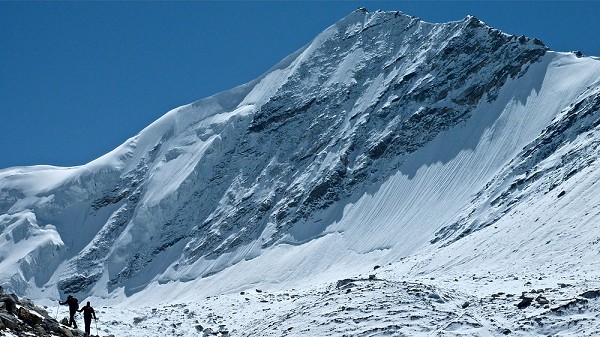
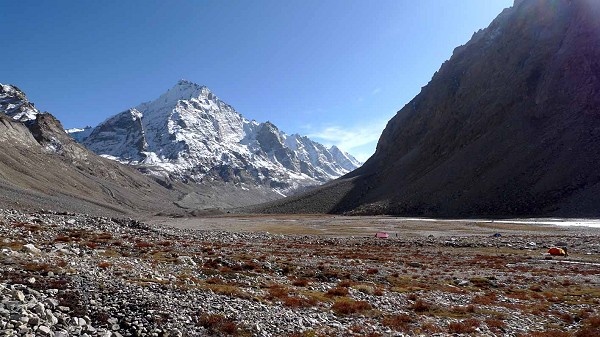
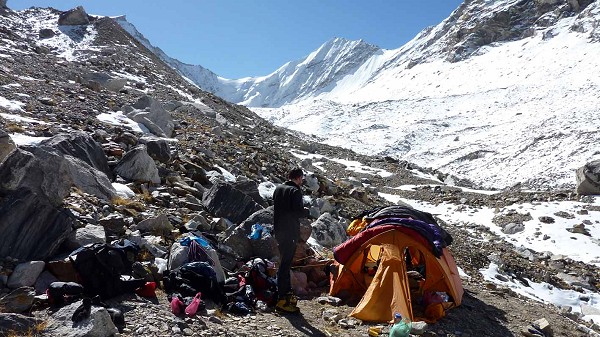
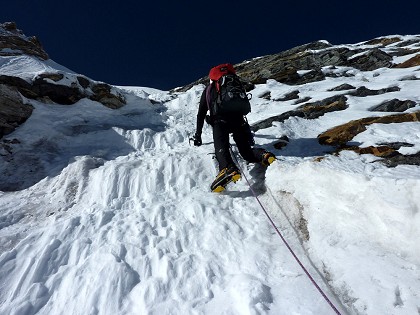
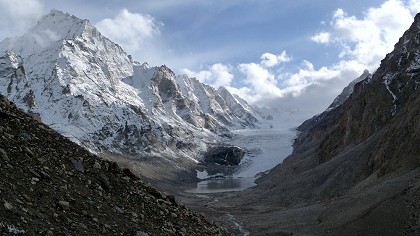
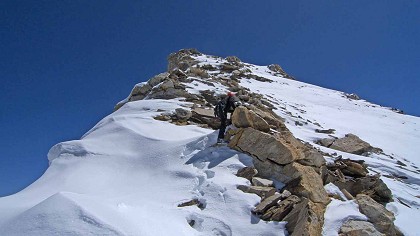
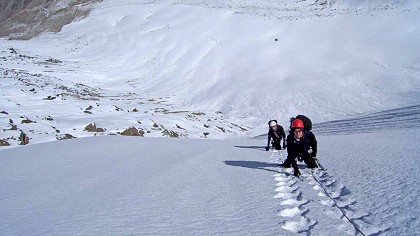

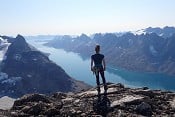
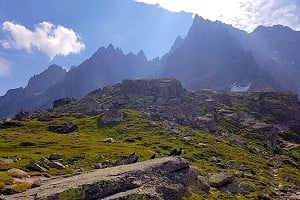
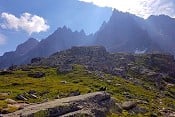
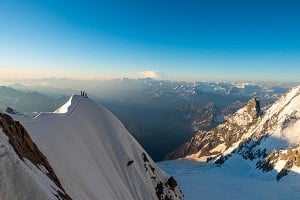
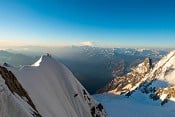








Comments